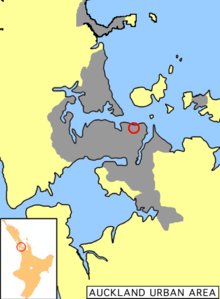Kohimarama
| Kohimarama | |
|---|---|

View of Kohimarama Beach
|
|

Location in Auckland
|
|
| Basic information | |
| Local authority | Auckland Council |
| Population | 7092 (2013) |
| Surrounds | |
| North | Rangitoto Island, Tamaki Drive |
| Northeast | Hauraki Gulf, Browns Island |
| East | St Heliers |
| Southeast | Glen Innes, Glendowie |
| South | St Johns |
| Southwest | Meadowbank |
| West | Mission Bay, Orākei, Ōkahu Bay |
| Northwest | Waitematā Harbour, Devonport |
Kohimarama is a coastal residential Auckland suburb, located to the east of the city, with many homes having some of the best views across the Auckland Harbour. Kohimarama is situated between Mission Bay and St Heliers and has an accessible beach with a boardwalk and green recreational spaces located amongst residential areas. According to the 2013 census, Kohimarama has a population of 7092. Local government of Kohimarama is the responsibility of the Orākei Local Board, which also includes the suburbs of Orākei, Mission Bay, St Heliers, Glendowie, St Johns, Meadowbank, Remuera and Ellerslie.
Kohimarama used to be part of the Kohimarama Block, land acquired by European settlers from the indigenous Māori. This was a large area, from Orakei-Mission Bay to the Tamaki River and from the Waitematā Harbour to the outskirts of Panmure. Kohimarama’s former name was Waiparera, ‘duck water’, as the area was a breeding ground of the parera, the wild grey duck. This name was used by the Māori and by the European settlers, the Pākehā, until 1870. Arriving in Auckland in 1841, William Field Porter, was a month too late for the first Government auction, but became the first settler in today’s Kohimarama after the second auction. Then the area consisted of a lagoon, a raupo swamp and the Kohimarama beach, the longest beach in the Harbour. Porter sent men to clear, fence and drain the area. One of these men was Thomas Kemp, later to be a landowner of the neighbouring suburb, Mission Bay.
The Kohimarama Wharf was built in 1912 on the Pipimea Head between Kohimarama and Mission Bay. The first business in Kohimarama was a tearoom which catered to the people arriving at the newly built wharf. The access to the wharf was not easy; people had to walk around the rocks to and from the wharf which ultimately led to the building of the road now known as Tamaki Drive.
...
Wikipedia
